6.4 Aim-TTi SMU4201 vs Keithley 2450
As of 8/26/23, both the Aim-TTi SMU4201 ($5,250) and the Keithley 2450 ($6,870), show enough similarities in their electrical capabilities, that it makes sense to compare them to see how they differ. Here I will compare both SMUs and try point out the differences so that potential buyers can make informed decisions on which one to purchase based on their needs.

6.4.1 Form factor
Both instruments have bumpers and handles and can be used either directly on the bench or on a rack. Both are ½ rack width and 2U heigh, with the bumpers and the handle the SMU4201 is 250 mm wide x 97 mm high, while the 2450 is 255 mm wide x 106 mm heigh. The depth on the other side is considerably different, with the SMU4201 being 269 mm deep, compared to the 403 mm of the 2450. The SMU4201 weights 4.25 Kg, while the 2450 weights 4.04 Kg.
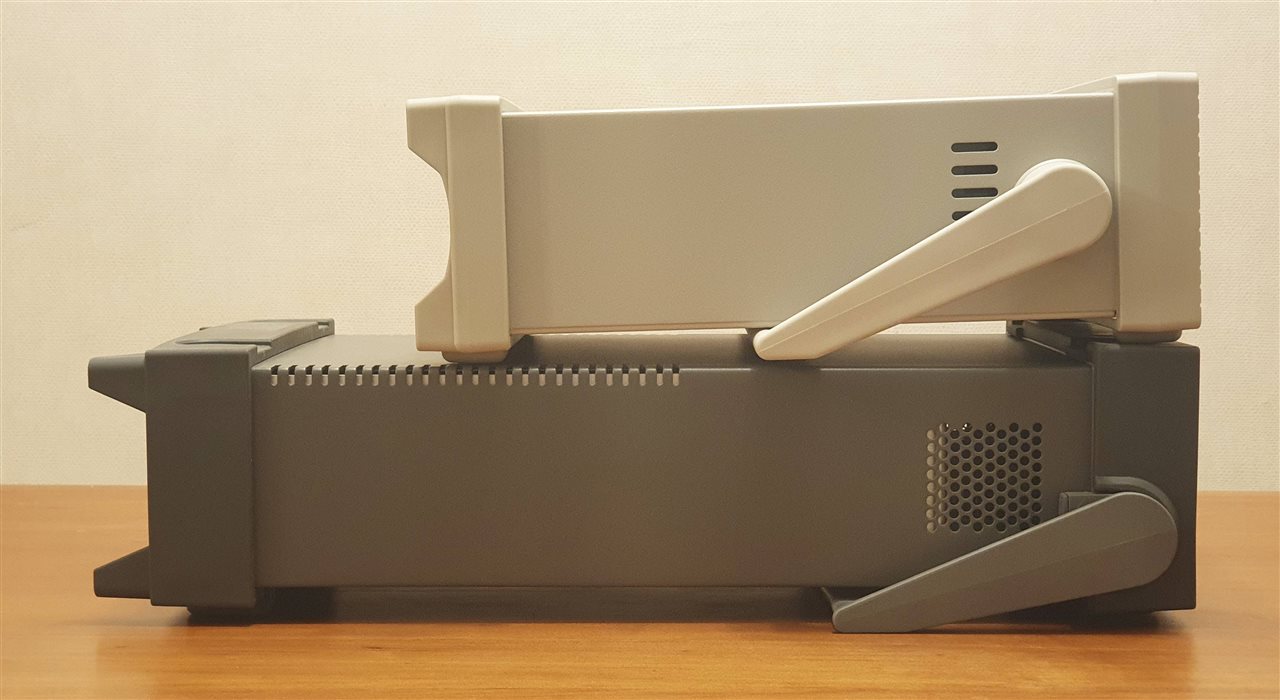
Both instruments use a touch screen and have a similar distribution of front-panel elements. The SMU4201 has a 480 x 272 4.3 inches screen, while the 2450 uses a 800x480 5 inches screen.

Comparing the back-panel of both instruments is much more interesting. Both provide a USB, LAN and GPIB connectivity, but for the SMU4201, the GPIB connectivity is offered as an option.
Both instruments provide a digital I/O port with a 5V (500 mA) pin that can be used to power external circuits, a ground pin, and general purpose I/O pins (5 on the SMU4201 and 6 on the 2450) that can be used to trigger or communicate with external circuits. The SMU4201 also provides a high voltage interlock pin, and a trigger input and trigger output pin to synchronize the SMU to other instruments or a secondary SMU. The 2450 also provides an interlock, but through a separate connector. The 2450 also provides a TSP-Link (RJ45) connector which allows multiple Keithley instruments that support the feature to be daisy-chained and synchronized.
Both SMUs offer two force terminals, two sense terminals, a ground, and a guard terminal, but the SMU4201 uses a terminal block, while the 2450 uses triaxial terminals. Triaxial cables and connectors provide extra immunity to external noise, but at a considerable cost.
6.4.2 Electrical characteristics
Both SMUs can reach up to 200 V, but the SMU4201 can deliver a maximum of 25 W, while the 2450 can deliver up to 20 W. The voltage/current capabilities of both SMUs is very different, The SMU4201 can reach its maximum power in a wide range of voltages, while the Keithley can reach its maximum power only at +/- 20 V and +/- 200 V.


Both instruments support 5 voltage ranges, that go from 20 mV up to 200 V, but the SMU4201 supports current ranges from 200 nA up to 3 A, while the 2450 goes from 10 nA up to 1 A. The measuring accuracy of both instruments is more or less close to each other.

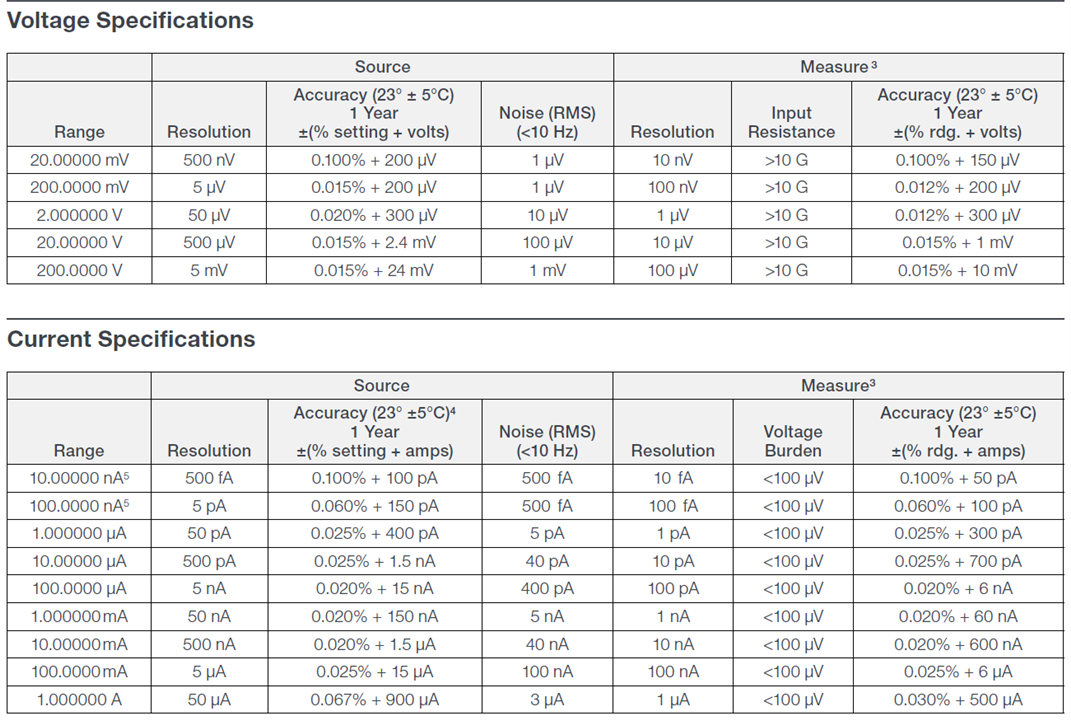
In terms of modes of operation, both SMUs can act as positive and negative voltages sources and as positive or negative current sources, but only the SMU4201 can also operate as a resistive or as a power load through a digital feedback loop.
The SMU4201 can measure up to 5 k/s and the 2450 can measure slightly over 3000 k/s. The buffer memory of the SMU4201 can store 100,000 measurements while the 2450 can store over 250,000 measurements.
6.4.3 Interfaces
6.4.3.1 Front-panel
Even though both instruments use a touch screen, their menu system approach differs considerably. The SMU4201 took a more traditional approach, using deeper hierarchical menus, while the 2450 in contrast took a more modern approach reminiscent of mobile phone user interfaces supporting a variety of touch gestures.
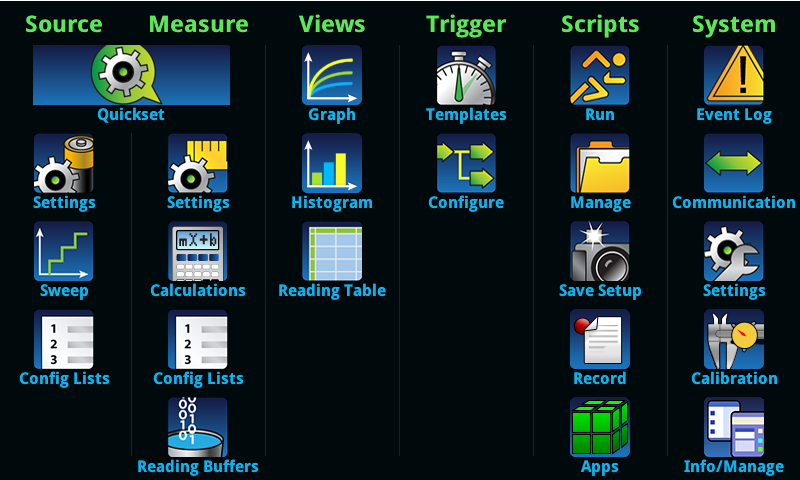
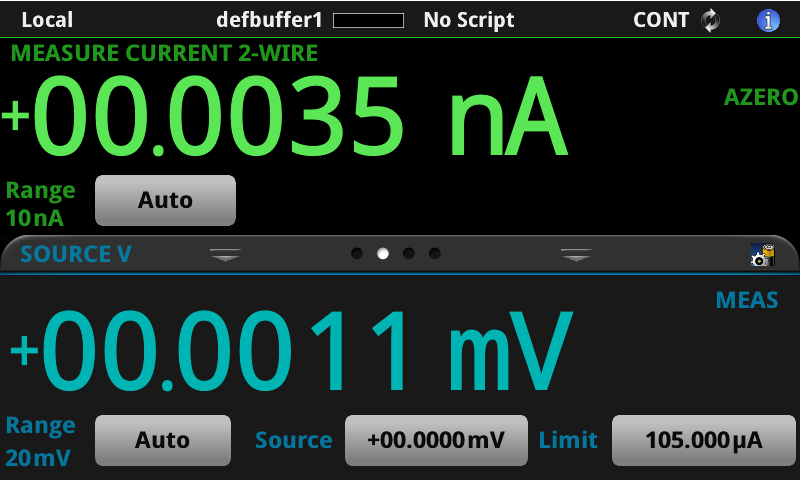
Functionality wise, both SMUs make it relatively easy to setup the instrument to perform common task. Also, both provide a simplified and an advanced way to setup the instrument, and support running “models” that give finer control over the instrument.
The SMU4201 offers more readily available testing options than the 2450, for instance the SMU4201 supports pulsed sweeps through the Manual Setup menu, while the 2450 doesn’t offer pulsed sweeps through the Source Settings.
One advanced feature of the 2450 is the config list, which allows a model to recall previously stored settings. This feature gives a lot of flexibility, but at the cost of higher setup complexity. A very interesting feature found only in the 2450, is its ability to run scripts and applications in the instrument itself to extend its capabilities.
6.4.3.2 Web
Both instruments provide a similar interface to setup the network and send SCPI commands, but the 2450 has a few extra menus to check the event log, and to download the measurement buffer.




The most relevant difference is that the 2450 provides a virtual front panel, which allows the user to control the instrument from the computer screen similar to how it would be controlled from the physical front-panel.

6.4.3.3 Remote control application
Aim-TTi and Keithley, both provide an application to remotely control their respective SMUs. Aim-TTi’s Test Bridge SMU is free as of 8/26/23, while Keithley’s Kickstart is not. For the same reason, here I will compare against Kickstart 2.6 (which is the last version that I could get for free). In terms of features, Test Bridge SMU exposes almost (if not all) the functionality available from the SMU front-panel, while Kickstarter does not expose important functionality such as a way to design and run models. On the other hand, in contrast to the front-panel menu system, Kickstart provides an easy way to generate pulsed sweeps. One nice feature of Kickstart is that it can display data as it gets measured by the SMU, in comparison, Test Bridge SMU retrieves the data only once it has finished making all the measurements.
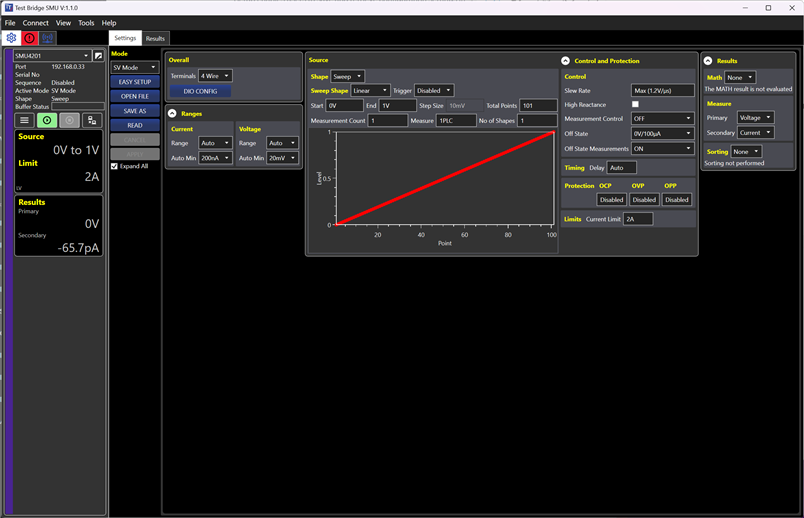
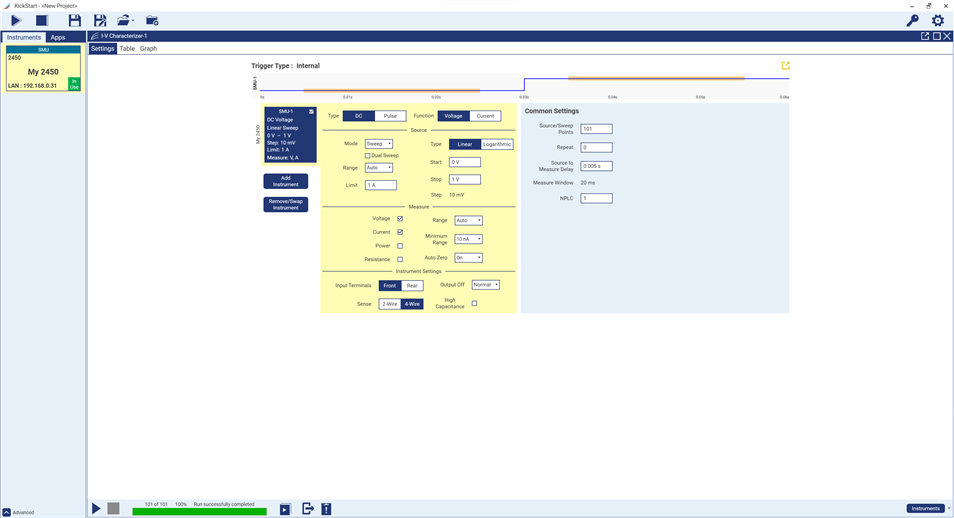
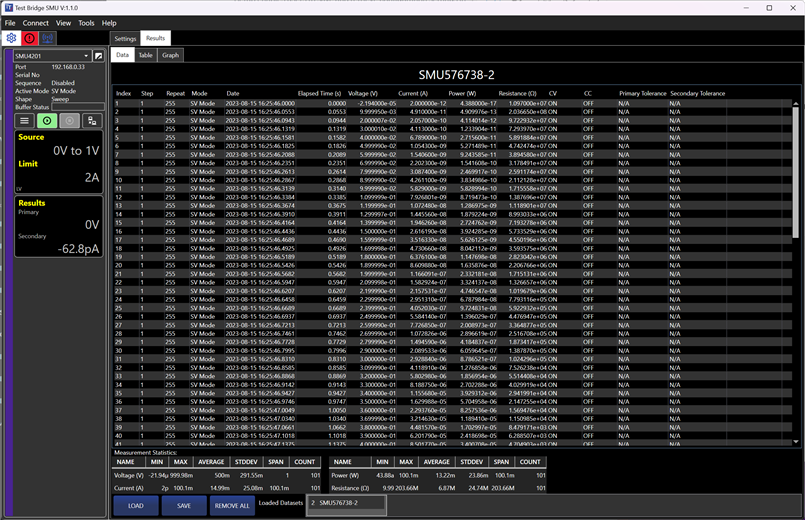
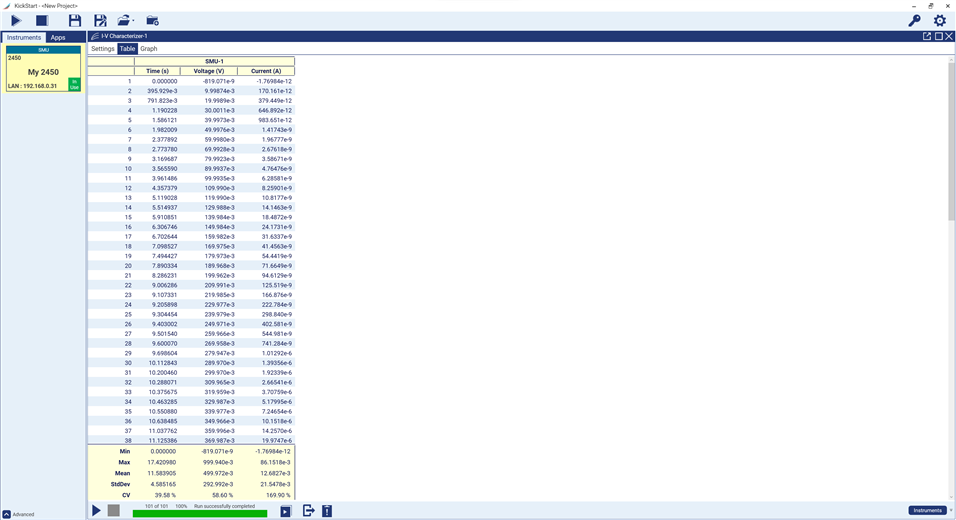
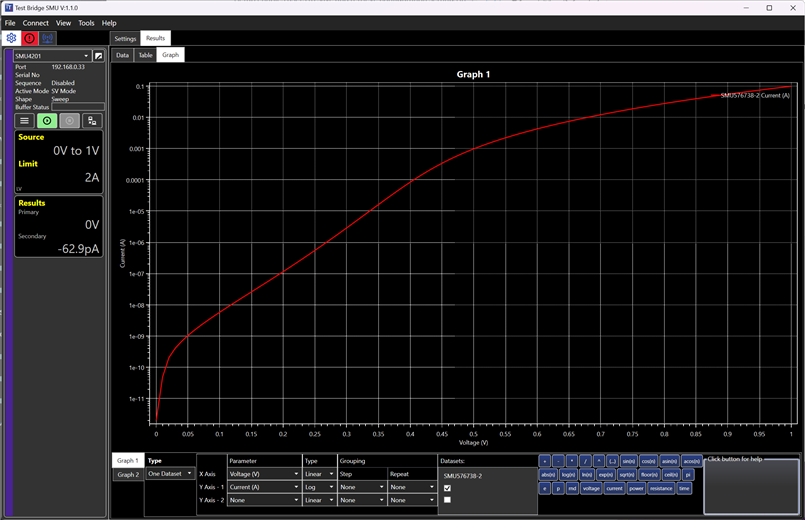
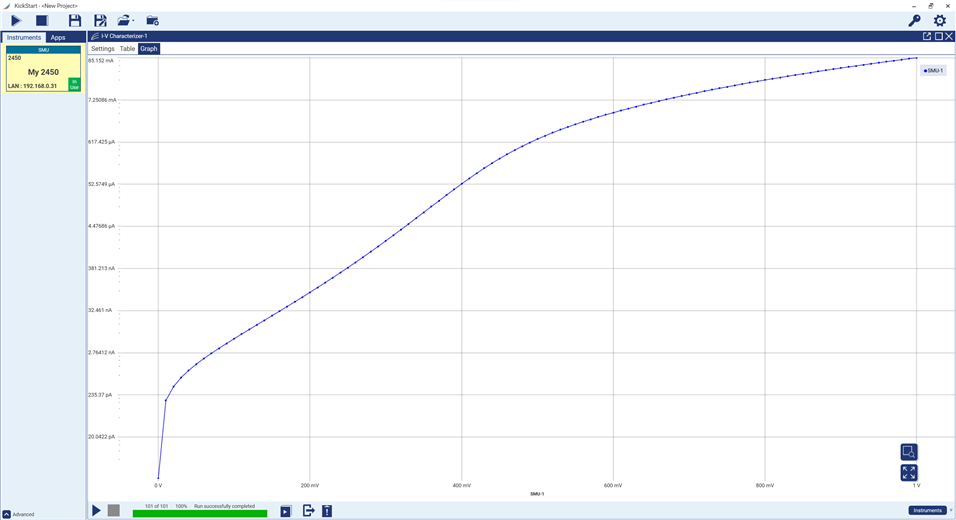
6.4.3.4 Remote control
Both instruments provide remote control access through a raw-TCP server, but the 2450 also provides access through a telnet and a VXI-11 server. Both support SCPI commands, but the 2450 also supports Test Script Processor (TSP) scripts. These scripts are actually LUA scripts that can run either remotely or directly on the instrument and can be used to extend the functionality of the instrument.
Proper documentation is fundamental when programming test equipment. The SMU4201 documentation is notably briefer than that of the 2450. To illustrate this, the image bellow shows how the *IDN? command is documented for each instrument.

6.4.4 Conclusions
As expected, there is no clear winner as both instruments have their pros and cons. A potential buyer will have to consider the differences and determine which instrument better suits their particular needs.
